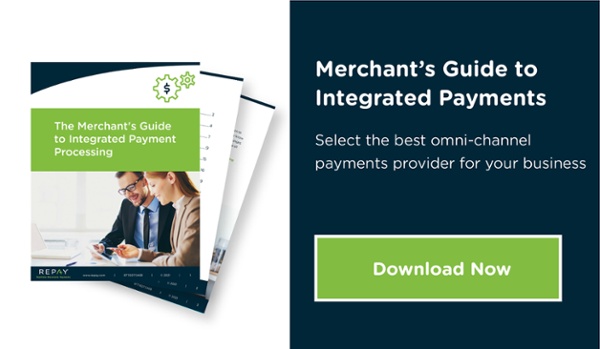In today's digital age, convenience, reliability and security are top of mind for companies wanting to keep their customers satisfied.
Merchant payment options continue to evolve as more customers shop online, use contactless payments for in-person purchases and seek to guard themselves against increasing fraud risks. That's where integrated payment processing comes in.
Integrated payment processing systems streamline business operations, increase security and improve accuracy. In addition to simplified transaction processing, integrated payment systems connect and work with other essential business platforms, such as accounting software and CRMs, to leverage customer data for more targeted communications, smarter upselling and more tailored customer experiences.
What is integrated payment processing?
Integrated payment processing supports seamless, end-to-end business processes by connecting the payment processing function, such as your online payment portal, hosted payment page or point of sale (POS) system, with your business’ operating software and systems. Essentially, integrated payment processing streamlines the flow of payment information, pushing the payment data to the places it needs to be to optimize back-office business operations.
For example, payments are automatically processed and posted to the relevant invoice or sale. This eliminates tedious tasks such as manually entering transactions, replicating the data into the accounting system or utilizing multiple reporting platforms.
Integrated payments vs. non-integrated payments
Non-integrated payments require human intervention to properly process payments and input those transactions into other software and systems. For example, if a POS system isn’t synced with a debit or credit card terminal, in-person transactions require you to manually enter transaction totals both before the customer can insert or swipe their card and after the transaction is completed for proper accounting and record-keeping.
For card-not-present transactions, when customers are ready to pay, the lack of payment integration means they'll be redirected to another payment processing website to submit their payment information. This makes the payment process longer and more tedious for the customer, increasing the likelihood that they’ll abandon the payment altogether. Although non-integrated payment processing may be less expensive, it’s time-consuming and exposes your business to costly mistakes and potentially lost business in the long run.
In contrast, integrated payment processing supports an uninterrupted payment experience for your customers by seamlessly enabling the payment terminal to communicate with other systems without human intervention.
What are the benefits of integrated payment processing?
It reduces accounting errors.
Accounting errors can lead to major back-office problems and inaccuracies with revenue reporting. Integrated payment processing minimizes this risk by automatically relaying transaction information from the point of payment to the proper destination, such as your accounting software. This eliminates manual data entry, makes it easy to accept and reconcile payments, and mitigates accounting discrepancies.
It saves time.
Manual tasks are time-consuming and laborious, but that's not an issue with integrated payment processing. The ability to integrate payment processing with an existing platform eliminates the need for redundant and error-prone data entry, ultimately saving you time from repeatedly inputting data into various systems. As a result, employees can better manage their time and allocate it to other business areas instead of focusing on back-end data entry. Additionally, the absence of manual transaction entry speeds up the payment process for customers.
It reduces your costs.
Integrating every aspect of payment processing is essential for helping businesses save money. Integrated payments eliminate manual transaction entry and reconciliation while reducing costly errors, and many solutions can be integrated to existing systems at no additional cost. This means fewer employee hours are allocated to reviewing and inputting transaction information and performing manual calculations, resulting in reduced labor costs.
It improves the customer experience.
With integrated payments, customers don't have to wait for customer service representatives to manually enter transaction information for in-person payments. For online transactions, customers can quickly and easily self-serve and enter their payment information without needing to call a support representative. Through one webpage, they can make a payment without the additional steps of being redirected to another payment site or requiring multiple logins. As a result, customers experience shorter in-person lines and wait times and faster online payment experiences.
It improves security.
By combining payment processing and accounting functions, it's less likely for security issues to arise. Integrated payment processing systems are encrypted and protect payment data throughout the entire transaction lifecycle. REPAY's integrated payment processing solution is Payment Card Industry Data Security Standard (PCI DSS) compliant to mitigate data breaches and fraud attempts and offers additional compliance for the key industries we serve.
Enhance your business with integrated payment processing
Modern integrated payment systems offer several benefits to help your business thrive and provide an enhanced customer experience. Creating a smooth and error-free payment process is just a click away. REPAY's integrated payment solutions enable a more streamlined, simplified and optimized payment process. Contact us today to learn how we can enhance your business.


